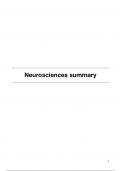Neurosciences summary
1
,Introduction to Neurosciences 3
Neuroanatomy I: An introduction 3
Neuroanatomy II: Basic structures 6
Neuroanatomy III: Basic functions 9
Neurophysiology 1a: Resting membrane potential 15
Neurophysiology 1b: Ion channels and transporters 17
Neurophysiology 1c: Action potential generation and conduction 20
Neurophysiology 2: Synaptic transmission 21
Neurophysiology 3: Neurotransmitter systems 26
Neurophysiology 4: Neuron-glia plasticity 31
Brain as part of the organism 1: The neuroendocrine system 34
Brain as part of the organism 2: Evolution of the brain and synapse 38
Brain as part of the organism 3: Circadian rhythms and sleep 43
Brain as part of the organism 4: Somatosensory system 49
Brain as part of the organism 5: Speech and language 53
Brain as part of the organism 6: The senses 55
2
, Introduction to Neurosciences
- Colors in the brain:
- Gray matter: cortex of the brain (lining the brain), containing cell bodies of neurons
- White matter: connects brain parts by containing large axonal tracts surrounded by lipid-
rich myelin (-> white color), connecting brain parts
- Prefrontal cortex: controls rational planning and decision making
- Stress system suppresses actions of prefrontal cortex -> football-players make o enses
when under pressure
- Cerebellum: controls coordination of movements
- Basal ganglia a ected in Parkinson’s disease -> impaired movement
- 3 main themes in neurosciences:
- Neuroanatomy: structure of the brain, where are the di erent brain areas and what is their
main function?
- Neurophysiology: processing of the brain, how do neurons communicate?
- Brain as part of the organism: how does the brain work as part of the body?
Neuroanatomy I: An introduction
- History of knowledge about the brain:
- Started with Edwin Smith Papyrus (~1600 b.C.): one of the most important medical
papyrus rolls, containing a lot of information about the brain
- 5400 years after: modern neuroscience
- Up to now: detailed graphics of the brain
- Neuroanatomy: branch of neurosciences that focuses on the macroscopic aspects of the NS,
being interested in locating and examining the structures that comprise the CNS and PNS
- It also comprises a microscopic and a functional part
- It is essential knowledge for neuropathology
- General organization of the nervous system:
- Macroscopic:
- Central vs peripheral nervous system
- CNS = brain + spinal cord
- Is e ector, main functioning part of the NS
- PNS = rest of NS (cranial+spinal nerves), connecting CNS to the rest of the body
- Consists of sensory system and motor system (with somatic vs visceral
motor division)
- Sensory vs motor component
- Sensory info from internal/external environment (via sensory receptors to
sensory ganglia+nerves) -> PNS -> CNS -> e ectors (of visceral/somatic motor
system) -> motor response (movement of muscles/glands)
- Visceral/autonomic motor system acts on smooth/cardiac muscles,
glands; subdivided into sympathetic ( ght/ ight; with ganglia lying along or
in front of vertebral column) vs parasympathetic (rest/digest; with ganglia
found in or adjacent to the organs they innervate), and enteric system (with
ganglia+neurons scattered throughout the gut wall)
- Somatic motor system consists of motor axons that connect the CNS to
skeletal muscles
3
ff ff fi fl ff ff ff
, - Microscopic:
- Neurons with axon (conducts electrical signals away from the neuron soma, thereby
transmitting info to other cells) and dendrites (propagating electrochemical signal
received from other neural cells to the neuron soma)
- Neuroglia: supporting cells that do not directly participate in electrical signaling
- Oligodendrocytes: present in CNS, creating myelin sheaths around axons,
thereby impacting the speed of transmission of electrical signals
- Schwann cells provide myelin in PNS
- Microglia: immune cell of brain, type of macrophage
- Astrocyte: present in CNS, maintaining an appropriate chemical environment for
neuronal signaling, incl. formation of the blood-brain-barrier
- General structure of the brain aka encephalon:
- 2 cerebral hemispheres (symmetric halves), connected by corpus callosum
- Encephalon is divided into 3 parts: cerebrum, cerebellum, truncus cerebri
- 5 main brain subdivisions: telencephalon, diencephalon, mesencephalon,
metencephalon, myelencephalon (‘tel die messen met mij’)
- Ends in spinal cord
- Speci c foramina (=holes) in skull, with speci c nerves/arteries/veins going through
- Foramen magnum: opening in occipital bone where spinal cord goes through
- Foramen rotundum: anterior opening in sphenoid bone where maxillary nerve goes
through
- Sphenoid bone is located in middle of the skull towards the front, in front of the
basilar part of the occipital bone
- Sella turcica: saddle-shaped depression in the body of the sphenoid bone,
containing the pituitary gland
- Foramen spinosum: posterior opening in sphenoid bone where middle meningeal
artery+vein and meningeal branch of mandibular nerve go through
- Foramen ovale: middle opening in sphenoid bone where mandibular nerve goes
through
- Superior orbital ssure: opening in sphenoid bone where
oculomotor+trochlear+ophthalmic+abducens nerve, ophthalmic vein, and
sympathetic bers go through
- Optic canal: canal in optic foramen (located in sphenoid bone) where ophthalmic
artery and optic nerve go through
- Orientation planes in neuroanatomy:
- 3 planes used: coronal/frontal (anterior-posterior), horizontal/axial (dorsal=superior,
ventral=inferior), sagittal (left-right, midsagittal=medial vs parasagittal=lateral)
- Anterior (front) vs posterior (back)
- Rostral (nose) vs caudal (lower spinal region)
- Rostral-caudal axis of forebrain is tilted forward due to cephalic exure during
embryogenesis
- Dorsal (top) vs ventral (bottom), due to curvature during embryonic development
- Medial (at midline) vs lateral (to the side)
- Meninges:
- Provide protection
- 3 layers that cover the encephalon and spinal cord (out>in): dura, arachnoid and pia
mater
- Pia mater directly encapsulates the brain cortex
- Between hemispheres and cerebrum/cerebellum, dura is thicker: falx cerebri
(between hemispheres) and tentorium cerebelli (between cerebellum and occipital lobe)
- Provides extra protection for brain
- Subarachnoid space: between arachnoid and pia mater, appears vacuumed with typical
trabeculae (‘sticks’), lled with CSF
- From subarachnoid space, villi/granulations expand into sinuses for drainage of CSF
4
fi fi fi fi fi fl





